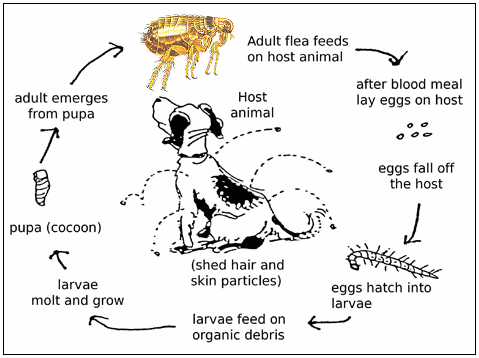|
Since you spend most of your time looking at hair, you may not realize if your dog has a skin problem. If she does, chances are that fleas are at the bottom of it. Most dogs that are bitten by fleas will experience some itching, but some dogs may also develop a severe allergic skin condition called flea allergy dermatitis.
Beyond the skin irritation, fleas may also contribute to the development of flea-bite
anaemia and the transmission of tapeworm parasites—a much harder itch to scratch. Adult fleas feed on the blood of their hosts, so heavy flea infestations can even lead to
anaemia from blood loss, which can be fatal. Adult fleas can also transmit tapeworms if ingested by your dog.
Understanding the Flea Lifecycle

It’s hard enough to keep a grip on what your animals are doing from minute to minute, much less having to worry about what’s happening beneath the fur. Here’s a glimpse at the battle being fought for your dog at the microscopic level.
Adult Fleas - lay microscopic eggs in your dog’s hair coat. Many of those eggs fall off your dog onto the carpet, bedding, furniture and anything else that’s lying around. Female fleas start producing eggs within 24 to 48 hours after taking their first blood meal and can lay up to 40 or 50 eggs per day. Adult fleas are susceptible to adulticide insecticides.
Flea Eggs - are resistant to the flea adulticide insecticides that do away with the full-grown fleas. They are susceptible, however, to Insect Growth Regulators (IGR) which nip their reproduction in the bud.
Flea Larvae - found in the pet’s environment aren’t yet old enough to give your dog much trouble, but they’re growing. Flea larvae feed on flea dirt (adult flea feces, if you really want to know--adult flea
faeces are actually digested blood of the pet). The larvae can move around in the environment to find the best climate for themselves. They gravitate toward heat, humidity and darkness as dryness and direct sunlight contact can kill them. They’re picky about their habitat because they aren’t especially tough. In addition to dryness and sunlight, flea larvae are susceptible to traditional insecticides as well as environmental IGR’s, including those shed in flea
faeces from the pet’s blood.
Flea Pupae - or fleas in the cocoon stage, are resistant to environmental changes such as freezing, drying, and both insecticides and insect growth regulators. Pupa can lie dormant for months or years and are stimulated to become adults with changes in appropriate environmental factors to become adult fleas. So how do you stop them? Don’t let them get to that stage by controlling fleas in the egg, larvae and adult stages. With the proper care and attention to the entire spectrum of flea development, your dog will be flea-free in no time.
 Flea-Bite Anaemia - fleas are like tiny vampires that feed on the blood of dogs. Of course, one flea can’t do too much damage, but with heavy infestations fleas can even ingest enough blood to cause
anaemia. Anaemia is the physical state of having a low number of blood cells and it can be fatal. Young puppies, small breeds or sick animals may be more prone to severe effects associated with
anaemia. Symptoms of flea-bite anaemia include weakness, pale gums and lethargy. If you suspect your dog has
anaemia, see your veterinarian immediately (a good rule whenever something serious seems to be happening). Treatment of
anaemia often includes blood transfusions and intensive supportive care, but with quick attention, an
anaemic dog can be brought back to full health. Flea-Bite Anaemia - fleas are like tiny vampires that feed on the blood of dogs. Of course, one flea can’t do too much damage, but with heavy infestations fleas can even ingest enough blood to cause
anaemia. Anaemia is the physical state of having a low number of blood cells and it can be fatal. Young puppies, small breeds or sick animals may be more prone to severe effects associated with
anaemia. Symptoms of flea-bite anaemia include weakness, pale gums and lethargy. If you suspect your dog has
anaemia, see your veterinarian immediately (a good rule whenever something serious seems to be happening). Treatment of
anaemia often includes blood transfusions and intensive supportive care, but with quick attention, an
anaemic dog can be brought back to full health.
 Flea-Bite Allergies - constant itching and scratching are clear signs that something unpleasant is happening to your canine crony, but it may be more complicated than some annoying fleas. Some dogs develop a severe allergic skin condition called flea-allergy dermatitis. Flea-allergy dermatitis occurs if your dog has an allergic reaction to the flea’s saliva. Symptoms seen in dogs with flea allergies include scratching (of course), chewing, licking, red, irritated skin and hair loss. Your veterinarian can diagnose flea allergies with an intradermal skin test and put an end to the problem. Flea-Bite Allergies - constant itching and scratching are clear signs that something unpleasant is happening to your canine crony, but it may be more complicated than some annoying fleas. Some dogs develop a severe allergic skin condition called flea-allergy dermatitis. Flea-allergy dermatitis occurs if your dog has an allergic reaction to the flea’s saliva. Symptoms seen in dogs with flea allergies include scratching (of course), chewing, licking, red, irritated skin and hair loss. Your veterinarian can diagnose flea allergies with an intradermal skin test and put an end to the problem.
Tapeworms - as if the itching and the allergies weren’t enough, fleas containing tapeworm eggs “Dipylidium caninum” can transmit a tapeworm infection to your dog when the flea is ingested. After being ingested, the tapeworm egg matures into an adult tapeworm that is segmented and can be 6 inches or more in length. While the flea clings to the outside, the tapeworm hooks on to your dog’s intestinal lining and absorbs nutrients that are passing through the intestinal tract. The segments contain eggs that are passed through the dog’s intestinal tract and expelled from the body with the stool. Tapeworm segments look like pieces of rice and can be found wriggling around the dog’s anus or present in the stool. Though they’re tiny, tapeworms can ultimately lead to weight loss and debilitation for the dog.
|

 Flea-Bite Anaemia - fleas are like tiny vampires that feed on the blood of dogs. Of course, one flea can’t do too much damage, but with heavy infestations fleas can even ingest enough blood to cause
anaemia. Anaemia is the physical state of having a low number of blood cells and it can be fatal. Young puppies, small breeds or sick animals may be more prone to severe effects associated with
anaemia. Symptoms of flea-bite anaemia include weakness, pale gums and lethargy. If you suspect your dog has
anaemia, see your veterinarian immediately (a good rule whenever something serious seems to be happening). Treatment of
anaemia often includes blood transfusions and intensive supportive care, but with quick attention, an
anaemic dog can be brought back to full health.
Flea-Bite Anaemia - fleas are like tiny vampires that feed on the blood of dogs. Of course, one flea can’t do too much damage, but with heavy infestations fleas can even ingest enough blood to cause
anaemia. Anaemia is the physical state of having a low number of blood cells and it can be fatal. Young puppies, small breeds or sick animals may be more prone to severe effects associated with
anaemia. Symptoms of flea-bite anaemia include weakness, pale gums and lethargy. If you suspect your dog has
anaemia, see your veterinarian immediately (a good rule whenever something serious seems to be happening). Treatment of
anaemia often includes blood transfusions and intensive supportive care, but with quick attention, an
anaemic dog can be brought back to full health. Flea-Bite Allergies - constant itching and scratching are clear signs that something unpleasant is happening to your canine crony, but it may be more complicated than some annoying fleas. Some dogs develop a severe allergic skin condition called flea-allergy dermatitis. Flea-allergy dermatitis occurs if your dog has an allergic reaction to the flea’s saliva. Symptoms seen in dogs with flea allergies include scratching (of course), chewing, licking, red, irritated skin and hair loss. Your veterinarian can diagnose flea allergies with an intradermal skin test and put an end to the problem.
Flea-Bite Allergies - constant itching and scratching are clear signs that something unpleasant is happening to your canine crony, but it may be more complicated than some annoying fleas. Some dogs develop a severe allergic skin condition called flea-allergy dermatitis. Flea-allergy dermatitis occurs if your dog has an allergic reaction to the flea’s saliva. Symptoms seen in dogs with flea allergies include scratching (of course), chewing, licking, red, irritated skin and hair loss. Your veterinarian can diagnose flea allergies with an intradermal skin test and put an end to the problem.